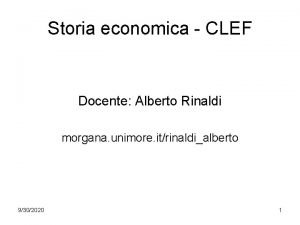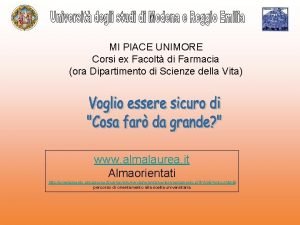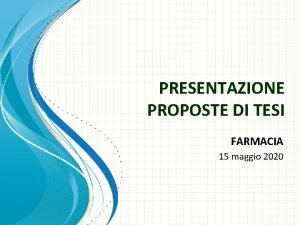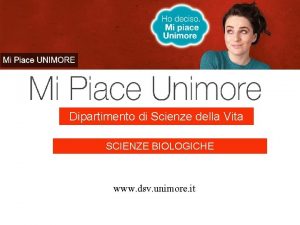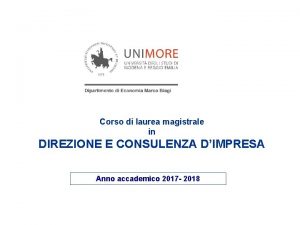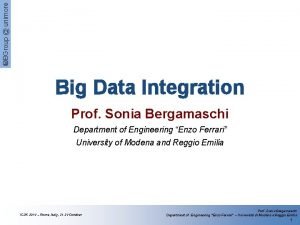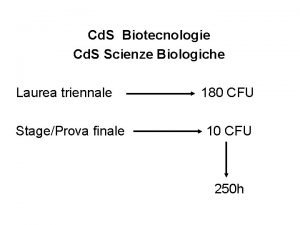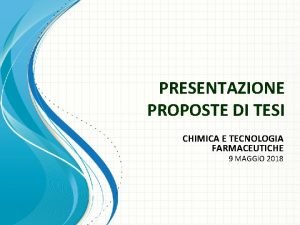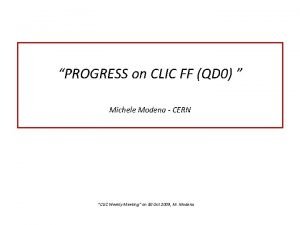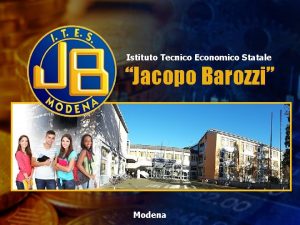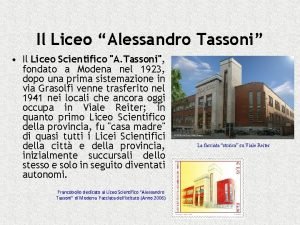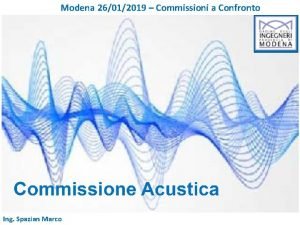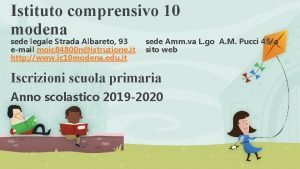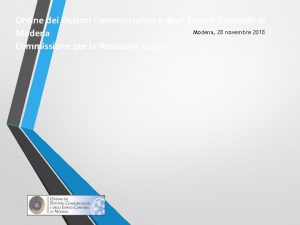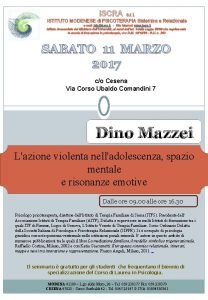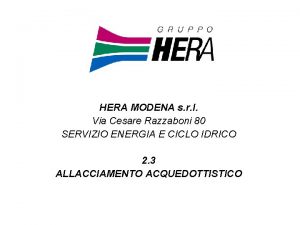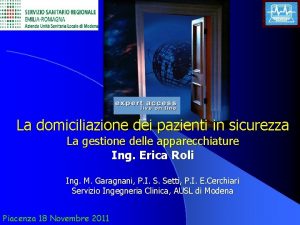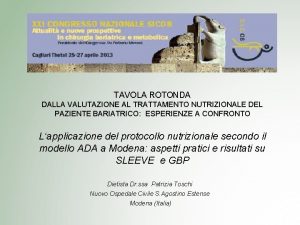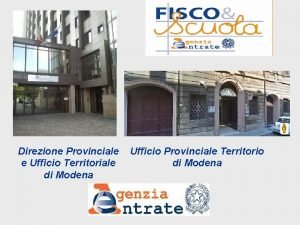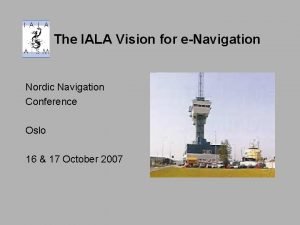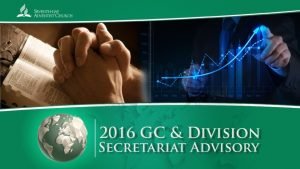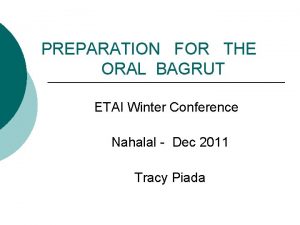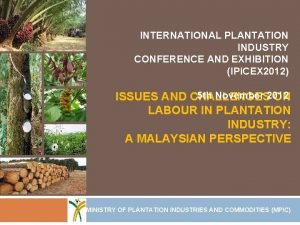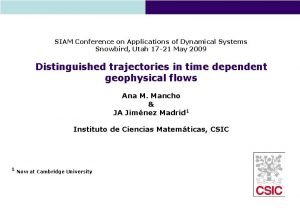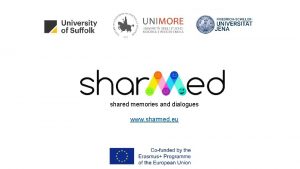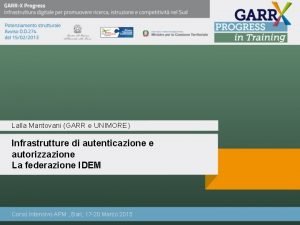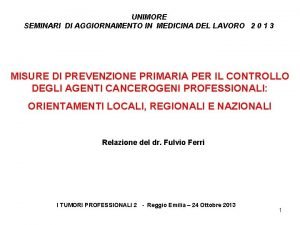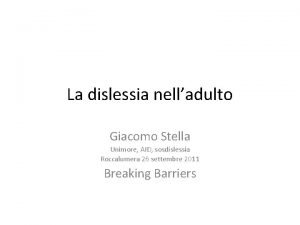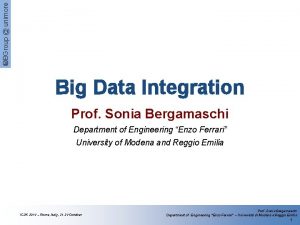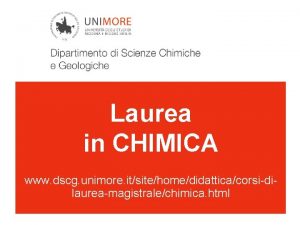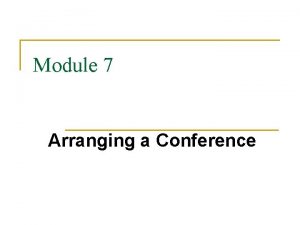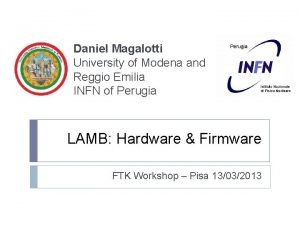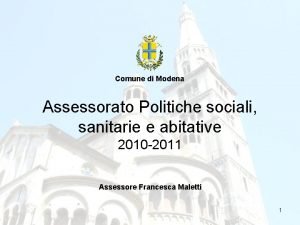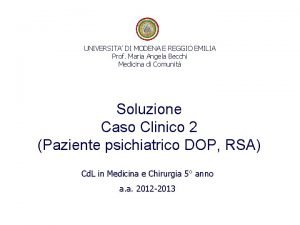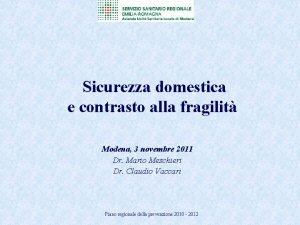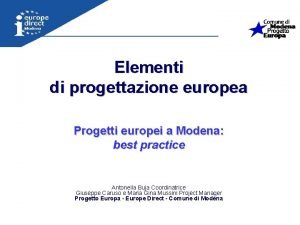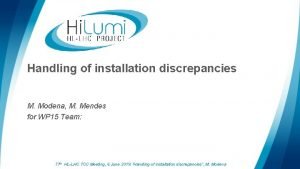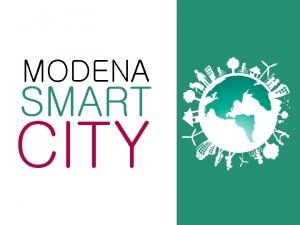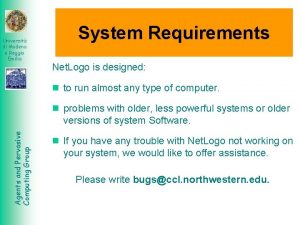Conference at UNIMORE on SHARMED Modena 10 11






























- Slides: 30

Conference at UNIMORE on SHARMED Modena, 10 -11 December 2018 Migration and Intercultural Education Prof. Dr. Cristina Allemann-Ghionda University of Cologne https: //www. hf. uni-koeln. de/40137 cristina. allemann-ghionda@uni-koeln. de Faculty of Human Sciences Department of Comparative Education and Social Sciences Prof. Dr. Cristina Allemann-Ghionda : 1 University of Cologne

Content 1. 2. Intercultural education: definitions, critique Beyond “cultural differences”, towards a broader concept: Education in and for diversity 3. Within this enlarged scope: 3. 1 What is specific about educating pupils with a migration history and family background? 3. 2 What should all children learn? 3. 3 Teachers and principals, their roles and competences 4. Conclusion Faculty of Human Sciences Department of Comparative Education and Social Sciences Prof. Dr. Cristina Allemann-Ghionda 2 University of Cologne

1. A historical definition of multicultural education … „an idea, an educational reform movement, and a process whose major goal is to change the structure of educational institutions so that male and female students, exceptional students, and students who are members of diverse racial, ethnic, language, and cultural groups will have an equal chance to achieve academically in school. “ J. A. Banks and C. A. M. Banks (Eds. ) (2007): Multicultural education: Issues and Perspectives. 6 th ed. Hoboken, NJ: Wiley and Sons, p. 1; quoted from Allemann-Ghionda (2009). 3

1. A historical definition of multicultural education This definition, generated in the United States, ü stresses that it is not merely about alleged „cultural“ differences ü points at the issue of equity in education ü proposes structural change 4

1. A further definition of intercultural education Education is intercultural when it recognizes the fact of linguistic and socio-cultural plurality (diversity) at the levels of organization, curriculum content and teaching methods. In all subject matters, different perspectives are included, compared analyzed critically. Cultures and languages of national minorities or of migrants may be part of this process depending on the circumstances. Independently from the physical presence of persons with different socio-cultural and language backgrounds, the key-idea is to respect any and every socio-cultural and linguistic expression. After Allemann-Ghionda, C. (2013: 60 ff. ). (Free translation by the author). 5

1. A further definition of intercultural education (continues) This is not obvious, knowing that many representations (for example in textbooks) imply an ethnocentric view, i. e. : the supposed superiority of Western civilization. An education that is intercultural and pluralistic transcends the dichotomy cultural minority/ majority. It offers knowledge and tools that are apt to enlarge the sociocultural horizon of each person. (. . . ) the construction of intercultural competence, i. e. : the capacity to analyse and to understand human diversity without reducing it to cultural « specificities » and « conflicts » . (after Allemann-Ghionda 2013: 60 ff. , free translation by author) Faculty of Human Sciences Department of Comparative Education and Social Sciences Prof. Dr. Cristina Allemann-Ghionda 6 University of Cologne

1. Early criticism of intercultural education • Intercultural education in Western Europe since the mid-1970 s: originally conceived as a pedagogical reaction to the increasing number of immigrants. • For a long time intercultural education put an excessive stress on « cultural differences » . In part of literature and in daily school practice, often still so. • Even if the intention is to counteract racism, insisting on « cultural differences » and on « ethnicity » can be understood as essentialism and serve the discourse of racism. Faculty of Human Sciences Department of Comparative Education and Social Sciences Prof. Dr. Cristina Allemann-Ghionda 7 University of Cologne

A long way since then: Essentialism and racism in a French school book, early 20 th century Faculty of Human Sciences Department of Comparative Education and Social Sciences Prof. Dr. Cristina Allemann-Ghionda 8 University of Cologne

1. Criticism of intercultural education today ü Critique of essentialism: cultural and other differences are social constructions, as opposed to nativism ü Unequal socio-economic status and economic inequality are probably more relevant than other disparities ü The aim of educational achievement has often been neglected Faculty of Human Sciences Department of Comparative Education and Social Sciences Prof. Dr. Cristina Allemann-Ghionda 9 University of Cologne

1. Early criticism of intercultural education and its actuality ü The concept of “human races” has no scientific (biological) basis. ü Yet today the issue of racism is more virulent than ever in many societies. ü Banned for decades from policy discourses and actions, racism reemerges in politics, society, and schools. Faculty of Human Sciences Department of Comparative Education and Social Sciences Prof. Dr. Cristina Allemann-Ghionda 10 University of Cologne

2. Beyond “cultural differences”, towards a broader concept: Education in and for diversity Faculty of Human Sciences Department of Comparative Education and Social Sciences Prof. Dr. Cristina Allemann-Ghionda : 11 University of Cologne

2. Beyond “cultural differences”, towards a broader concept: Education in and for diversity Migration is, of course, an extremely relevant reason to propose and practice „intercultural education“ or „education in diversity“. But we need to see the whole picture. Faculty of Human Sciences Department of Comparative Education and Social Sciences Prof. Dr. Cristina Allemann-Ghionda 12 University of Cologne

2. Migration is one aspect of cultural and social diversity: The four axes model Migration es d an tu ul s re c g ua g an fl o y sit ld a on r ive i r nt at an I Allemann-Ghionda (2013: 48) European integration Gl o tra bal is n m ob sna atio ilit tio n y na an d l Faculty of Human Sciences Department of Comparative Education and Social Sciences Prof. Dr. Cristina Allemann-Ghionda 13 University of Cologne

2. Migration is global and diversified Faculty of Human Sciences Department of Comparative Education and Social Sciences Prof. Dr. Cristina Allemann-Ghionda 14 University of Cologne

2. Plurality of languages and cultures in Europe: intertwined with the languages and cultures of migration More and more languages of migrants = languages of the EU More and more languages and cultural exchange between countries and continents, i. e. not only limited to Europe Faculty of Human Sciences Department of Comparative Education and Social Sciences Prof. Dr. Cristina Allemann-Ghionda 15 University of Cologne

2. Diversity: Not merely „cultures“ in the ethnic or national sense, but intersecting / overlapping “lines of difference” • socio-economic status, often linked to educational level and qualification • ethnic and socio-cultural affiliation (self-ascription, hetero-ascription) • nationality, citizenship; national and local identities • sex / gender / sexual orientation • age • ability / disability / physical and emotional well-being • skin-colour and other apparent physical features • religion, faith, spirituality, incl. the lack or refusal of them (Dietz 2007) University of Cologne Faculty of Human Sciences Department of Comparative Education and Social Sciences Prof. Dr. Cristina Allemann-Ghionda 16

2. Diversity: a dynamic (not static) concept • „In an essentialist view cultural and other elements are regarded as static; • Critique of essentialism: cultural and other elements or factors perceived as differences are defined as social constructions (as opposed to nativist) views. • Today‘s mainstream stance in social sciences, roughly since the early 21 st century: socio-economic status and inequality, as well as gender, are seen again as more relevant than cultural and other differences“. (Allemann-Ghionda 2017) Faculty of Human Sciences Department of Comparative Education and Social Sciences Prof. Dr. Cristina Allemann-Ghionda 17 University of Cologne

2. „Super-diversity“ and social change In society: Ø Migration is highly diversified Ø Many facets of diversity have become more visible and more accepted (Vertovec 2007) Ø Buy many aspects of migration are controversial In society and in the political discourse about diversity: Ø the return of inequality as a public concern Ø the return of biology to justify racial difference Ø the return of the sacred as a key terrain of public contestation (Brubaker 2015) University of Collogne Faculty of Human Sciences Department of Comparative Education and Social Sciences Prof. Dr. Cristina Allemann-Ghionda 18 University of Cologne

2. Super-diversity and migration ü ü Migrants come for many different reasons Increasing impact of the refugee / asylum issue Many different countries of origin Many different social backgrounds, levels of education and qualifications ü Greater variety of religions and lifestyles ü Large number of non accompanied children and youth who seek asylum Today‘s migrants = all „lines of difference“ What does this imply for „education in diversity“? Faculty of Human Sciences Department of Comparative Education and Social Sciences Prof. Dr. Cristina Allemann-Ghionda 19 University of Cologne

3. Within this enlarged (diversity) scope: 3. 1 What is specific about educating pupils with a migration history and family background? 3. 2 What should all children learn? 3. 3 Teachers and principals: their roles and competences Faculty of Human Sciences Department of Comparative Education and Social Sciences Prof. Dr. Cristina Allemann-Ghionda 20 University of Cologne

3. 1 What is specific about teaching pupils with a migration history and family background? Ø Social, geographic and national origin of pupils and students reflects the “super-diversity” of society Ø General goals of education are and must be constant for all pupils (no two-categories education) Ø Some tasks in education are specific because of the diversified public: language issues, different expectations towards education, religious and sociocultural factors. Faculty of Human Sciences Department of Comparative Education and Social Sciences Prof. Dr. Cristina Allemann-Ghionda 21 University of Cologne

3. 1 What is specific about teaching pupils with a migration history and family background? • The language issue: respecting and teaching the languages of migrants (L 1) is just as important as teaching the language of the arrival society (L 2) • Acknowledging the diversity of religions and sociocultural patterns is necessary; possible conflicts Is the goal of integration compatible with the idea of intercultural education or education in diversity? Yes, by all means. Faculty of Human Sciences Department of Comparative Education and Social Sciences Prof. Dr. Cristina Allemann-Ghionda 22 University of Cologne

3. 1 On the importance of balanced identities and acculturation: Integration = best option Four distinct acculturation profiles: integration, ethnic, national, diffuse „(Youth) with an integration profile had the best psychological and sociocultural outcomes, while those with a diffuse profile had the worst; in between, those with an ethnic profile had moderately good psychological adaptation but poorer sociocultural adaptation, while those with a national profile had moderately poor psychological adaptation, and slightly negative sociocultural adaptation. “ (Berry et al. 2006) Faculty of Human Sciences Department of Comparative Education and Social Sciences Prof. Dr. Cristina Allemann-Ghionda 23 University of Cologne

3. 1 On the importance of balanced identities and acculturation „The integration path appears to be generally the most beneficial. However, other ways of acculturating, particularly the ethnic or separation orientation, can be beneficial in some cases. The ethnic orientation contributes to both types of adaptation, but to a lesser extent than integration. This implies that a policy allowing immigrants to maintain separation if they wish to, for example by allowing immigrants to settle within their own ethnic communities, is preferable to a policy that would push immigrants to assimilate, for example by denying cultural and language rights, or by promoting scattered settlement over wide areas of a country. Clearly, a policy of exclusion, leading to the marginalisation of youth, has nothing to recommend it as a public policy. “ (Berry et al. 2006) Faculty of Human Sciences Department of Comparative Education and Social Sciences Prof. Dr. Cristina Allemann-Ghionda 24 University of Cologne

3. 2 Acknowledging diversity in education Explicit sensitivization to diversity, based on children‘s daily life Knowledge about religions; ethics Informed awareness about migration and minorities Overall context: Superdiversity Global mobility History curriculum: not only national; knowledge about democracy Faculty of Human Sciences Department of Comparative Education and Social Sciences Prof. Dr. Cristina Allemann-Ghionda Active multilingualism, Knowledge about Multilingualism Classroom support to all pupils who need it, not ethnically separated

3. 3 Teachers and principals: their roles and competences • Knowledge and skills that enable to act in a context of migration and super-diversity: enlarged intercultural competence • Knowledge about multilingualism including its pedagogical and didactic implications • Readiness to communicate with parents (families) Educational institutions must provide support to teachers and principals: clear rules to prevent and solve conflicts, translation services Faculty of Human Sciences Department of Comparative Education and Social Sciences Prof. Dr. Cristina Allemann-Ghionda : 26 University of Cologne

4. Conclusion • Education prepares pupils to live, work, and be responsible citizens in an interdependent world, even if they may not leave their countries of origin. • Education in diversity is not only for „foreigners“, but for all pupils or students. • Curriculum content should abstain from ethnocentric representations and reflect human diversity in nonhierarchical ways. • Ambivalent role of digital communication; learn / teach critical use of digital information. Faculty of Human Sciences Department of Comparative Education and Social Sciences Prof. Dr. Cristina Allemann-Ghionda 27 University of Cologne

4. Conclusion ü Openness to diversity does not mean absolute cultural relativism ü Guiding criteria: o Respect of the Constitution of the country in which one lives and is educated (Examples: Italy, Germany, US) o Democratic, liberal education under changing conditions (Gutmann 1987/1997; Oelkers 2018) Faculty of Human Sciences Department of Comparative Education and Social Sciences Prof. Dr. Cristina Allemann-Ghionda 28 University of Cologne

References Allemann-Ghionda, C. (2009): From intercultural education to the inclusion of diversity: Theories and policies in Europe. In Banks, J. A. (Ed. ). The Routledge International Companion to Multicultural Education. New York / London: Routledge. (134 -145). Allemann-Ghionda, C. (2013): Bildung für alle, Diversität und Inklusion: Internationale Perspektiven. Paderborn: Schöningh. Allemann-Ghionda, C. (2015): Dealing with Diversity in Education: A Critical View on Goals and Outcomes. In: Matejskova, T. /Antonsich, M. (Eds. ): Governing through Diversity. Migration Societies in Post-Multiculturalist Times. (125 -142) Basingstoke: Palgrave Macmillan Allemann-Ghionda, C. (2017): International Implications of Educating in Diversity. Keynote Speech at Conference „Diversity Education in a Global Society – National Concerns and Transnational Influences“, University of Nuremberg-Erlangen, 18 -20 October 2017. Berry, J. W. / Phinney, J. S. / Sam, D. L. / Vedder, P. (2006): Immigrant Youth: Acculturation, Identity, and Adaptation. Applied Psychology: An International Review, 55 (3), 303 -332. Brubaker, R. (2015): Grounds for Difference. Cambridge (MA): Harvard University Press. Dietz, G. (2007). Keyword: Cultural Diversity. A Guide Through the Debate. Zeitschrift für Erziehungswissenschaft 10(1): 7 -30. Gutmann, Amy (1999): Democratic Education. With a New Preface and Epilogue. Princeton: Princeton University Press. Faculty of Human Sciences Department of Comparative Education and Social Sciences Prof. Dr. Cristina Allemann-Ghionda 29 University of Cologne

Oelkers. J. (2018): Autoritarismus und liberale öffentliche Bildung. Zeitschrift für Pädagogik, Vol. 54, 728 -747. Vertovec, S. (2007): Super-diversity and its Implications. Ethnic and Racial Studies 29, 1024 -1054. Alcuni titoli in italiano Allemann-Ghionda, C. (2016): Migrazione e integrazione scolastica in Germania: Tendenze e nuovi compiti. Civitas educationis. Education, Politics and Culture, Vol. V, N° 1 (117 -128). Allemann-Ghionda, C. (2015): Educazione e diversità: ripensare parametri, riconoscere nuove sfide. Civitas educationis. Education, Politics and Culture, Vol. IV, N° 2 (51 -65). Bolognesi, I. (a cura di) (2014): Educazione interculturale. Culture, esperienze, progetti. Trento: Edizioni Centro Studi Erickson. Portera, A. / Böhm, W. / Secco, L. (2007): Educabilità, educazione e pedagogia nella società complessa. Lineamenti introduttivi. Novara: De Agostini Scuola. Faculty of Human Sciences Department of Comparative Education and Social Sciences Prof. Dr. Cristina Allemann-Ghionda 30 University of Cologne
 Sociologia dei consumi unimore
Sociologia dei consumi unimore Ctf unimore
Ctf unimore Dsv unimore
Dsv unimore Segreteria studenti unimore educazione
Segreteria studenti unimore educazione Scienze biologiche unimore
Scienze biologiche unimore Cinzia parolini unimore
Cinzia parolini unimore Dbgroup unimore
Dbgroup unimore Dolly unimore scienze naturali
Dolly unimore scienze naturali Cigs unimore
Cigs unimore Tesi ctf unimore
Tesi ctf unimore Michele modena
Michele modena Istituto jacopo barozzi modena
Istituto jacopo barozzi modena Scuola tassoni modena
Scuola tassoni modena Commissioni ing direct
Commissioni ing direct Istituto comprensivo 10 modena
Istituto comprensivo 10 modena Stefano orsi commercialista modena
Stefano orsi commercialista modena Iscra modena
Iscra modena Hera modena
Hera modena Intranet ausl modena
Intranet ausl modena Analisi e consulenza finanziaria modena
Analisi e consulenza finanziaria modena Esempio menu dopo sleeve
Esempio menu dopo sleeve Moic84200
Moic84200 Ufficio scolastico provinciale modena
Ufficio scolastico provinciale modena Iala conference 2019
Iala conference 2019 Fasfaa conference
Fasfaa conference Cipfa conference
Cipfa conference Missionary care conference
Missionary care conference Etai conference
Etai conference Critical commodities conference
Critical commodities conference Cex conference
Cex conference Siam conference on applications of dynamical systems
Siam conference on applications of dynamical systems
